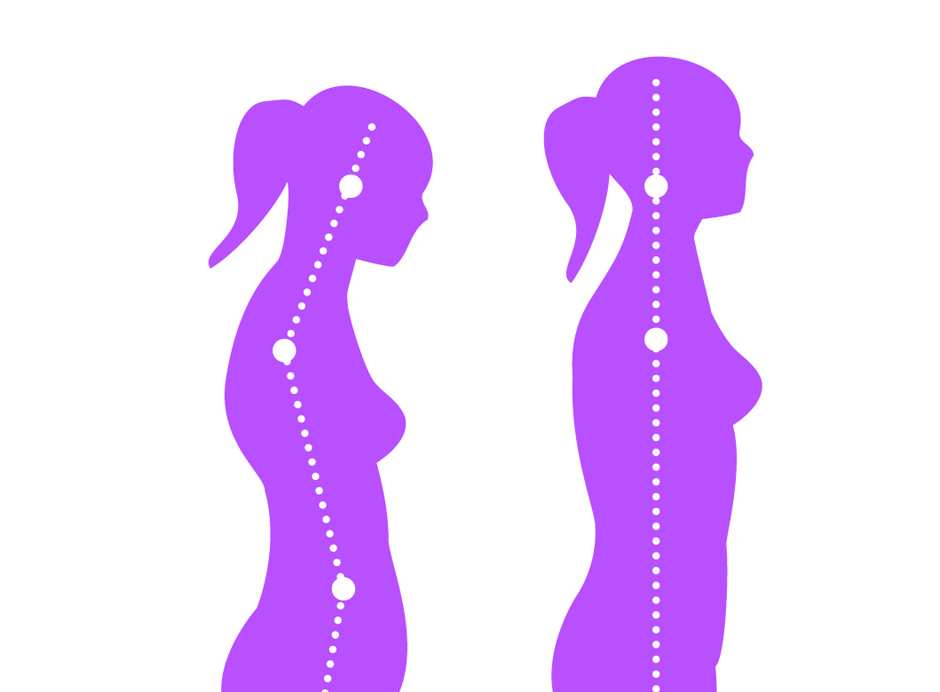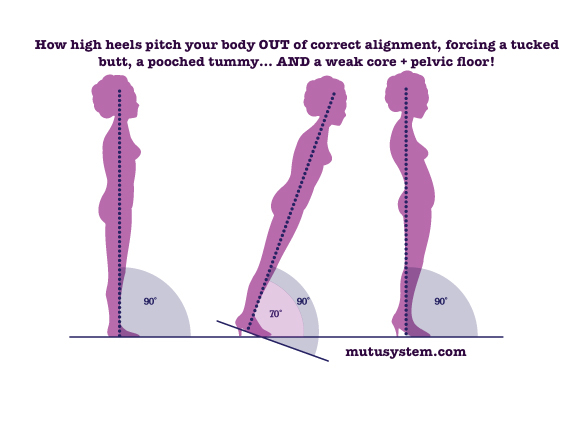Raise your hand if your body is in perfect alignment. …Yeah, me neither. Wendy Powell of MuTu System is here to tell us why proper alignment is important and how to get there.
If you’ve ever compared your body in pre-pregnancy pictures to post-baby shots of you looking rounder, softer and ‘still pregnant’, the thought may have crossed your mind that pregnancy wrecked your body. You’d kinda love to have those toned abs back and not the ‘mummy tummy’ that’s appeared there instead.
But Diastasis Recti (abdominal separation) – the reason your tummy won’t lie flat – is not caused entirely by pregnancy. Pregnancy just made it obvious and pushed it wider. It’s a symptom of high pressure in the abdomen and it can be fixed, or at least greatly improved.
Lowering the pressure is essential. You can’t firm up the midline of your abs, nor can you solve other pressure-related problems (such as pelvic organ prolapse, hernia, varicose veins and hemorrhoids) without tackling the root cause.
The way to return intra-abdominal pressure to a normal level is to realign your whole body and iron out any kinks in the way that your body sits, stands, walks and moves.
I’m not talking about standing tall, pulling your shoulders back and walking around with a book balanced on your head! Alignment is not the same as posture and getting it right may involve retraining your body after years of carrying it ‘wrong’.
Plus, of course, nine months of pregnancy, during which your confident stride metamorphosed into a ‘waddle’. Then probably six months of caring for a newborn, in which propping your tired body semi-upright was a plausible alternative to being vertical.
Sitting too much, planting our weight on our coccyx instead of our sit bones, not walking enough, wearing heeled shoes, sucking in our stomachs, tucking our butts under… we’ve learned some pretty bad habits in our journey to ‘civilisation’ – and our bodies would certainly prefer that we lived a more primitive life… but that’s another story!
How to stand
Standing in proper alignment involves stacking the three main cavities of the body (thoracic, abdominal and pelvic) neatly on top of each other. A vertical line should link all axes of the body. Your ribs should not be thrust out (‘shoulders back’, doesn’t mean ‘chest out’) your butt should not be tucked under or clenched (pushing your pelvis forward); and your knees should not be bent.
‘Wrong’ alignment increases the pressure in your abdominal cavity:
- When the ribs are thrust out, or the butt is tucked, or the stomach is sucked in, the abdominal cavity is ‘pinched’, causing pressure to rocket. As the spine acts as a boundary line at the back, the pressure tries to escape up, down, or forward.
- Forward pressure impacts the abdominal muscle, which can cause diastasis recti; upward pressure can result in hernias; while downward pressure can cause hernias, pelvic organ prolapse and other types of pelvic floor dysfunction.
‘Right’ alignment decreases pressure and gives all of the above conditions a chance to improve – making a full post-natal recovery a possibility. Without checking our alignment, diastasis recti will not heal. The gap where the abdominal muscle connective tissue is stretched and weak will not narrow while it is continually under pressure.
Repercussions
Diastasis recti and a weak pelvic floor are red flags that intra-abdominal pressure is over-the-top. Without lowering the pressure, these problems won’t get better and could spiral into further issues, such as hernias and pelvic organ prolapse.
Without lowering the pressure, the midline of your body will not firm up and your core will continue to be unstable. No matter how much you train, your core will not be fully functioning and strong and you will not get the flat tummy you remember from ‘before’.
What else helps?
There isn’t one trick, or one set of exercises that ‘cures’ diastasis recti. There are a number of ‘fixes’ that work together:
- Proper alignment of your full body
- Breathing fully into the back of your ribs (costal breathing) rather than your belly or up in your collarbone
- Connecting with and engaging your pelvic floor and transverse abdominis muscles
- Doing focused, gentle, safe core exercise that respects your mama body
- Eating the right food that nourishes your body and helps it heal
Alignment alone is not going to kiss your ‘the gap’ goodbye! But without it, the healing process can’t even get started.
MuTu System is a complete, holistic system that has all these bases covered.
If you have any questions about my post, please holler in the comments and I’ll answer you. I hope I’ve helped!
For more information on the MuTu System, click here. As always, InspiredRD readers get 15% off any MuTu System with the code “INSPIRED15”.
This post contains affiliate links.
Previous posts by Wendy Powell:
Eat well to heal your diastasis recti – How good nutrition can help your body to close “The Gap”
2 Diastasis Recti Fixes that WON’T Work – And What Will
A Diastasis Expert Answers All of Your Questions




[…] How Better Alignment Helps Fix Diastasis Recti […]
Hi Wendy,
What causes the pressure in the abdominal wall? Just mal-alignment?
Hi, check out all the causes + explanations on my ‘Diastasis 101’ article here! (with links to my free video series) https://mutusystem.com/diastasis-recti
[…] How Better Alignment Helps Fix Diastasis Recti […]
[…] How Better Alignment Helps Fix Diastasis Recti […]
Hello,
Thank you for this great post. I have a question for you. My wife has 3-4 finger diastasis recti after giving birth to our son for months ago, and has now discovered a pelvic prolapse. Do you think the prolapse would correct itself if she corrects the DR? How exactly are the two related? Thank you.
Hi David, both issues are stemming from a mal-alignment / un-contained pressure problem… see more here – useful information on prolapse https://mutusystem.com/pelvic-organ-prolapse-why-kegels-arent-enough.html
I’ve just come across your website, educated myself and now know the cause of my realy bad lower back pain and soreness. I did not know I had diastasis recti until I did the test. I believe that I have a nearly three wide gap at the belly button, not sure how deep but it’s certainly not firm.
Yesterday and today I’ve gotten to know my lower ab muscles/pelvic floor muscles again and have played with fixing my alignment. Honestly today I broom swept my floor without any discomfort, with out any lower back tension!!! OMG!! First time in years. ( 7 years post partum, two pregnancies close together) all because I engaged my pelvic floor and minded my alignment while doing the task. If taking the time to do those few excercises and realigning myself have helped THAT much already I now have high hopes for getting past this. Thank you so much for providing this great information, I feel like I would have continually only gotten worse had I not found this. Any other words of wisdom you could pass on to me? I feel like I’m dreaming to experience this result so quickly. Even years ago when seeing physiotherapist for my back pain, she never ever mention Diastasis Recti or tested me for it. Thank you so much.